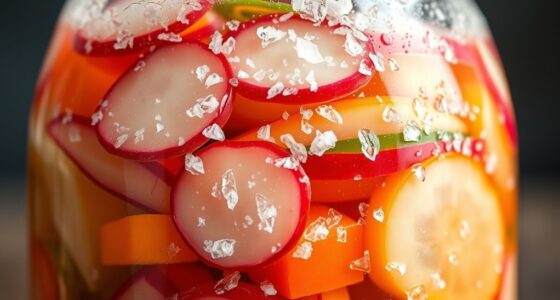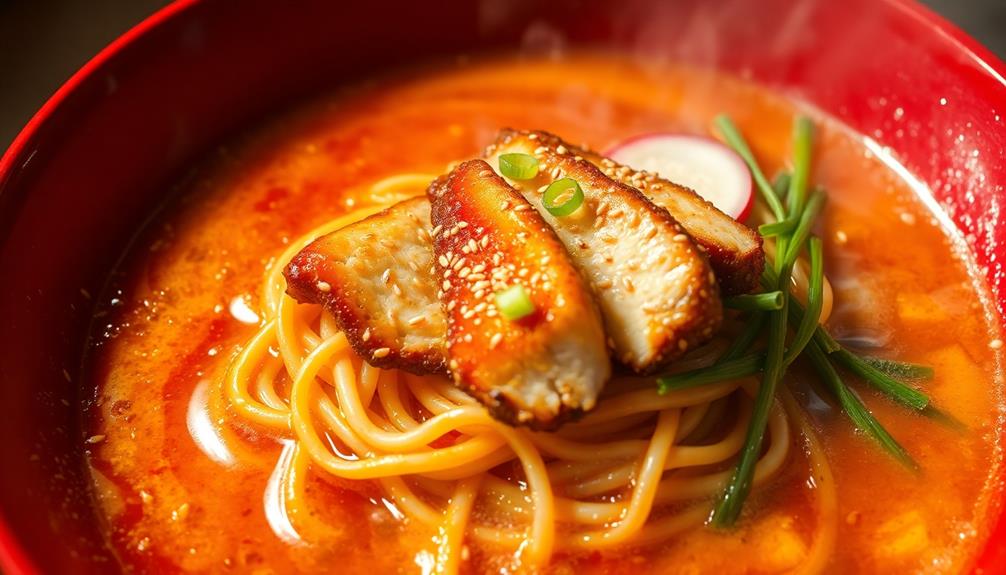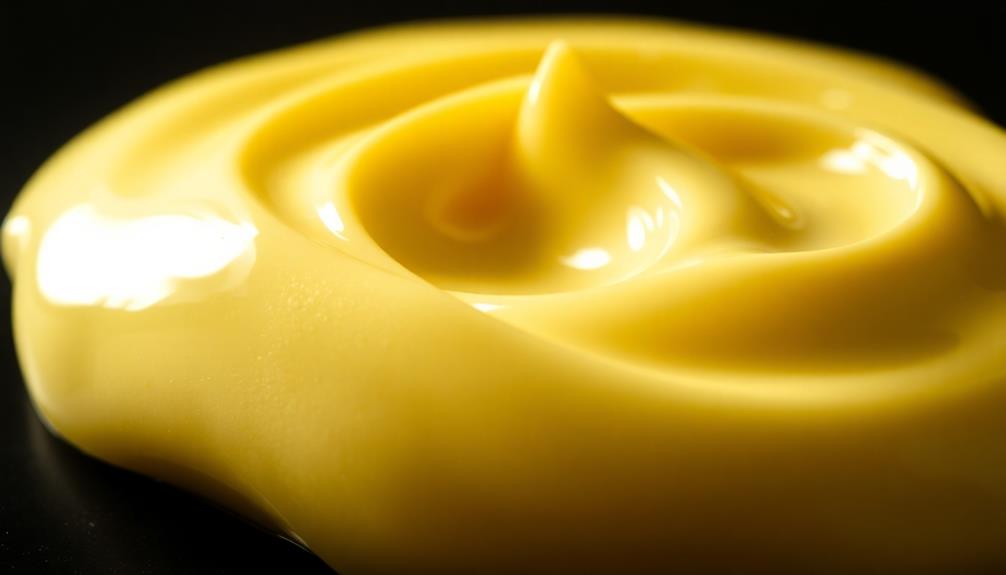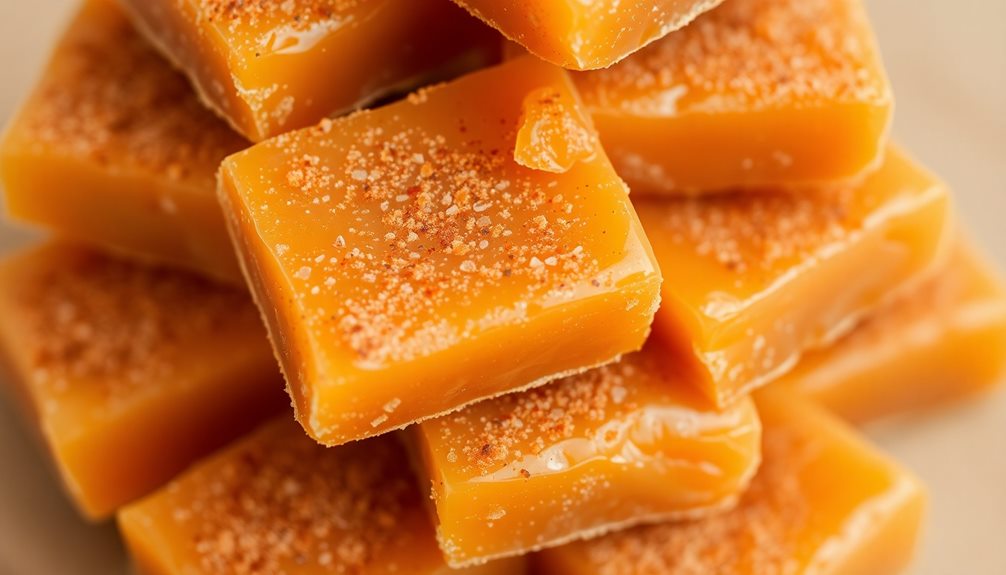Brining your turkey is a simple way to make it juicy and flavorful. You soak the bird in a salty, seasoned solution before cooking, which helps it retain moisture and adds taste. Using a non-reactive container and keeping everything cold is key. Vary your seasonings for different flavors—herbs, citrus, spices—and guarantee proper brining time. Keep these tips in mind, and you’ll master the art of perfect turkey every time. If you want to learn more, keep exploring!
Key Takeaways
- Brining keeps turkey juicy, tender, and flavorful by increasing moisture retention during cooking.
- Use a non-reactive container large enough for full immersion, such as a cooler or resealable bag.
- Dissolve salt and sugar completely, then add herbs, spices, or aromatics for customized flavor infusion.
- Refrigerate the turkey in the brine for 8-24 hours, then rinse and pat dry before roasting.
- Proper brining enhances taste, moisture, and tenderness, making your turkey more savory and festive.
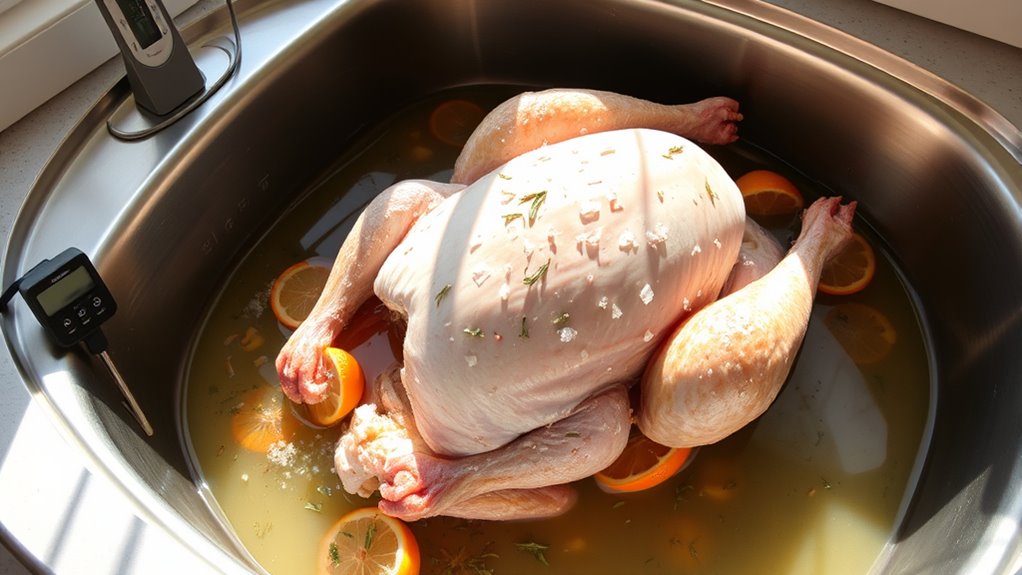
Ever wondered how to guarantee your turkey stays juicy and flavorful? Brining is the answer, and understanding the basics can make all the difference in your holiday feast. One key to perfect brining is experimenting with seasoning variations. You can keep it simple with salt and sugar, or add herbs, spices, citrus, or even aromatics like garlic and onion to infuse your bird with complex flavors. The choice of seasonings depends on your taste preferences and the flavor profile you want to achieve. For instance, a classic herb brine with rosemary, thyme, and bay leaves offers a savory, fragrant taste, while a citrus-spiced brine with orange zest and peppercorns adds brightness and zest. Don’t hesitate to get creative—adding a touch of maple syrup or chili flakes can give your turkey an unexpected twist. Just keep in mind that the seasoning variations should complement the natural flavor of the turkey and suit the meal theme.
Equally important is selecting the right brine container options. The container you choose must be large enough to fully submerge your turkey without spilling and should be made of non-reactive material like food-grade plastic, glass, or stainless steel. Avoid using aluminum or anything that might react with the salt or acids in your brine, which could alter the flavor or damage the container. If you don’t have a large enough container, consider using a clean, food-grade cooler or a heavy-duty resealable plastic bag designed for brining. These options make it easier to guarantee the bird remains fully immersed, which is vital for even flavor absorption. When using a bag, double-bag it to prevent leaks, and place it inside a tray or on a rack to catch any drips.
The key to successful brining is consistency and proper execution. Be sure to fully dissolve your salt and sugar in the water before adding your seasonings, and keep the container refrigerated throughout the process. Depending on the size of your turkey, brining can take anywhere from 8 to 24 hours. After brining, rinse the bird thoroughly under cold water to remove excess salt, then pat it dry before cooking. This step guarantees your turkey is flavorful, moist, and tender when it hits the oven. With the right seasoning variations and a suitable brine container, you’ll elevate your turkey to new heights of deliciousness—guaranteed.
Frequently Asked Questions
Can I Brine a Frozen Turkey?
You can’t brine a frozen turkey directly. First, you need to fully thaw your frozen turkey in the fridge, which might take several days depending on its size. Once thawed, prepare your brine, making sure it’s completely dissolved and cooled before submerging the turkey. Proper brine preparation ensures even flavor and moisture, so don’t skip this step. Plan ahead to give your turkey enough time to thaw and brine properly.
How Long Can I Leave a Turkey in the Brine?
You can leave a turkey in the brine for 12 to 24 hours, depending on its size. Unlike marinating, brining involves soaking in a saltwater solution, which helps it retain moisture. Dry brining offers benefits like less mess and skin crispiness. If you want maximum flavor and juiciness, stick to the recommended time, but avoid over-brining, which can lead to an overly salty taste.
Is It Safe to Reuse Brine?
You should never reuse brine because it’s a recipe for food safety issues. Reusing brine risks cross-contamination from raw poultry, which can harbor bacteria. Even if you boil the brine, it might not eliminate all pathogens, especially if it’s been contaminated. It’s best to discard used brine and make fresh for each turkey to guarantee safety and prevent foodborne illnesses. Better safe than sorry when it comes to your holiday feast.
What Are Alternatives to Traditional Brining?
If you want alternatives to traditional brining, consider dry brining, which involves rubbing salt and seasonings directly onto the turkey’s skin, enhancing flavor and moisture. Vegetarian substitutes like marinating vegetables or using flavorful herbs and citrus can also add moisture and taste without using liquid brine. Both methods are safer, reduce mess, and give you delicious, juicy results without the need for soaking in a traditional brine.
Do I Need to Rinse the Turkey After Brining?
You don’t need to rinse the turkey after brining if you want to maximize flavor enhancement and guarantee food safety. Rinsing can wash away surface salt and bacteria, but it also risks cross-contamination. Instead, simply pat the bird dry with paper towels to remove excess moisture. This step helps prevent sogginess and keeps the skin crispy, so your turkey stays flavorful, safe, and perfectly cooked.
Conclusion
Now that you know the secret to juicy, flavorful turkey, go ahead—brine like a pro! Just remember, your bird isn’t auditioning for a beauty pageant, so don’t obsess over perfect skin. Embrace the salty, flavorful magic, and enjoy the compliments (and maybe a few jealous glances). After all, a little patience and salt can turn your Thanksgiving from “meh” to “wow.” Happy brining, and may your turkey be forever moist!



